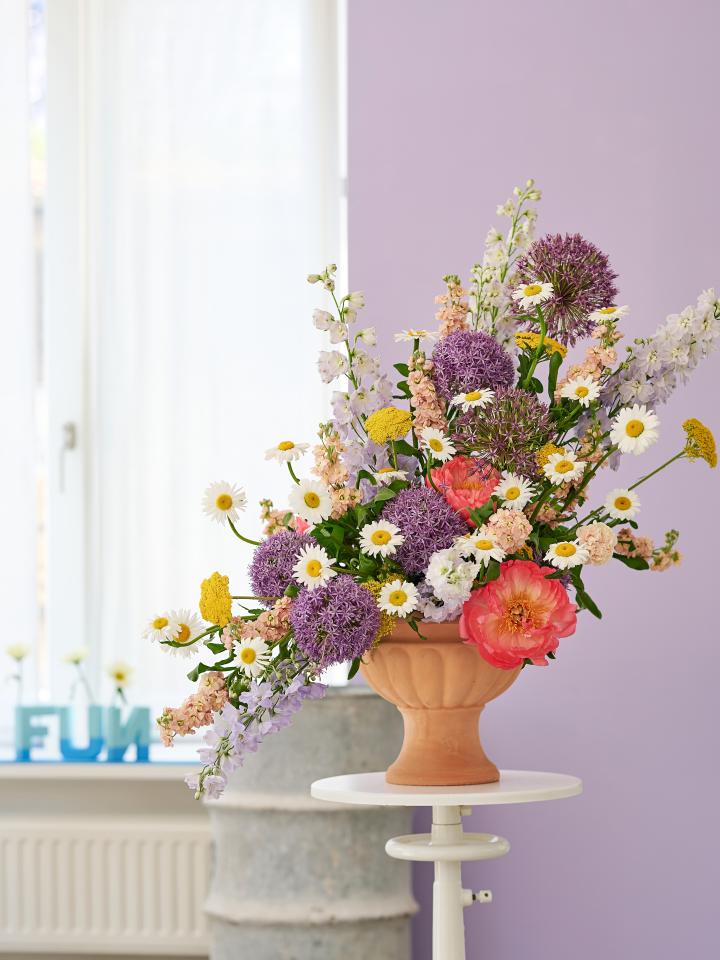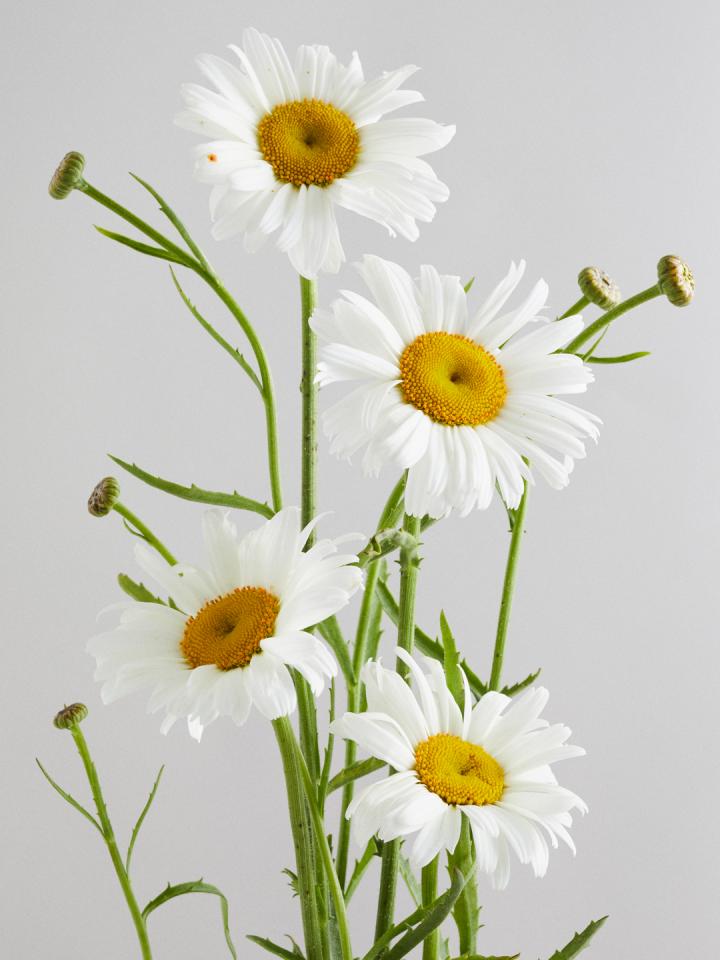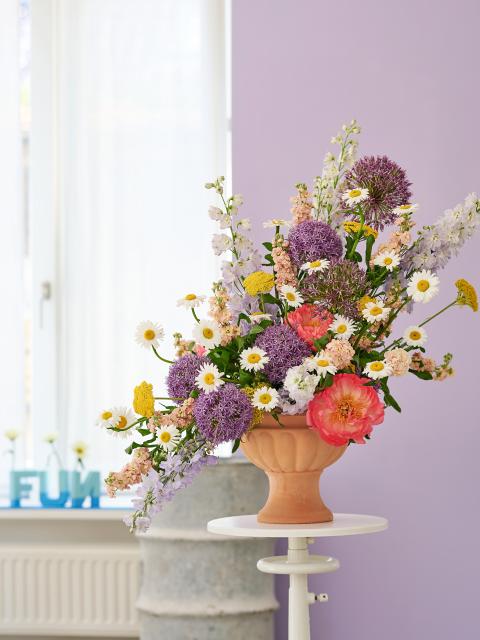DAISIES: CHARACTERISTICS AND FLOWERS
The well-known daisy flowers are characterised by white, cream or sometimes pink petals with a yellow centre. They look a bit like sunflowers and the flowers can be single or double, depending on the variety.
Daisies are very suitable as cut flowers and are popular in spring and summer bouquets. As a perennial, daisies flower abundantly, with the blooms lasting a long time. Depending on the variety, daisies flower from late spring to early autumn (May to October).
Marguerite daisies, also called Leucanthemum or Paris daisy, belong to the composite family (Asteraceae). This includes flowers such as sunflower, aster and chrysanthemum. Daisy used to be classified under Chrysanthemum, but research showed that daisy is a different genus. Leucanthemum is not aromatic and the leaves lack the grey-white hairs that Chrysanthemums have.
WHAT COUNTS AS A DAISY?
It is a daisy...or not? Some plants that aren't scientifically classified as daisies are nevertheless known as daisies, probably because it's such a well-known flower that similarly shaped blooms are mistaken as daisies. For instance, the Spanish daisy is regularly mistaken as being related to daisy, as is shrub daisy, or summer daisy. There are two species that can be called true daisies, namely the ‘common daisy’ and the ‘large-flowered daisy’. These two groups are in turn subdivided into various species.
- Common daisy: the common daisy, also called wild daisy or meadow daisy (Leucanthemum vulager) is by far the best known and most common group. The common daisy has white petals and a yellow heart. It is hardy and evergreen and usually flowers from May to September. You also find the common daisy along roadsides and in meadows growing wild. The common daisy grows about 40-50 centimetres high.
- Large-flowered daisy: the large-flowered daisy, also known as Leucanthemum maximum, is a hardy perennial. It produces large, white flowers with a yellow centre. The large-flowered daisy grows about 70-80 centimetres high.

HOW TO CARE FOR DAISIES AS CUT FLOWERS IN YOUR VASE
Have you brought home an exuberant bunch of daisies? Then you'll want them to last for as long as possible in your vase. The tips below for daisy-related care will help you keep your cheerful blooms thriving for as long as possible:
- Trim the flower stems diagonally with a sharp knife.
- Remove the lower leaves to prevent them from falling into the water and causing bacterial growth.
- Place daisies in a clean vase with a small layer of water at room temperature.
- Change the vase water regularly.
- If necessary, add cut flower food to extend the shelf life of your daisies.
- Do not put daisies in full sun, near the heating, near a fruit bowl or in a draught.
DAISY PLANTING AND CARE TIPS
Dreaming of a garden filled with daisies? They're sure to put you in a sunny mood, as well as attracting bees, butterflies and other insects, and are great for biodiversity. If you plant daisies in your garden, keep in mind the tips below for planting and caring tips:
- Daisies are summer bloomers. The ideal time to plant them is in spring, after the chance of frost has passed. Plant daisies about 30 centimetres apart. Want to know how to plant daisies? Check out a step-by-step plan for planting garden plants here.
- Daisies thrive best in a sunny or semi-shady spot that's sheltered, such as near a garden hedge.
- Daisies grow well in different types of soil, such as clay, sand and loamy soil. They do well in both acidic and alkaline (pH neutral) soils.
- Give daisy organic fertiliser to promote growth and flowering. You can do this as a precaution, or if you see that the plant is not doing well and needs some love.
- Make sure daisy gets enough water in the summer months and doesn't dry out.
- Daisies are hardy but not evergreen: the leaves fall off in winter.
HOW TO PRUNE DAISIES
Pruning daisies is simple and should preferably be done twice a year: after the first flowering and in autumn, after the second flowering.
- Pruning daisies in summer (after the first flowering): after the first flowering in summer, prune the daisies back substantially. The chances are that the daisy will then bloom again in late summer and you can enjoy the blooms twice in a year.
- Pruning daisy in autumn: if the branches start to wither in autumn (after the second flowering), you can prune your daisy back thoroughly, to about 10 centimetres above the ground. In spring, the stems will sprout again and the plant's leaves will return.

DAISY MEANING AND SYMBOLISM
'They love me...they love me not'. Picking daisy's white petals is a well-known superstition to determine if your lover truly does have feeling for you. That superstition probably stems from the symbolism attributed to the flower, as daisy symbolises love, loyalty and purity in many cultures. Daisies also symbolise cheerfulness, sunshine and warmth.
DAISY ORIGINS
The word daisy comes from the Ancient Greek 'margarites', which in turn comes from Babylonian and means 'pearl. Leucanthemum is derived from the Ancient Greek words 'leukos' = 'white' and 'anthemon' = 'flower' and refers to the daisy's white blooms.
Daisies are native to Europe, North Africa and temperate zones of Asia, and can be found even in Australia and New Zealand. The daisy dates back to the Ancient Greeks and Romans where the flower was used as a decoration, as well as for medicinal purposes. In the Middle Ages, daisy was seen as a symbol of purity. From the 19th century, daisy became popular as a garden plant and cut flower in bouquets.
ARE DAISIES POISONOUS?
Daisies are not toxic to humans or animals. In fact, both the flowers and the leaves of daisy are edible. The petals are often found in salads or other dishes, and you can also make tea from daisy flowers.
It's important never to eat just any old flower or plant and only to consume flowers from specialised suppliers that have been grown for consumption.
THE DIFFERENCE BETWEEN CHAMOMILE AND DAISY
Chamomile and daisy plants are often confused with each other. They look similar, yet are different. Chamomiles are larger than daisies, with daisies often growing to about 5-10 centimetres, while the chamomile can grow up to 60 centimetres tall. Chamomile is also very similar in appearance to daisies, but chamomile can be recognised by its protruding yellow heart and warm, sweet fragrance.






